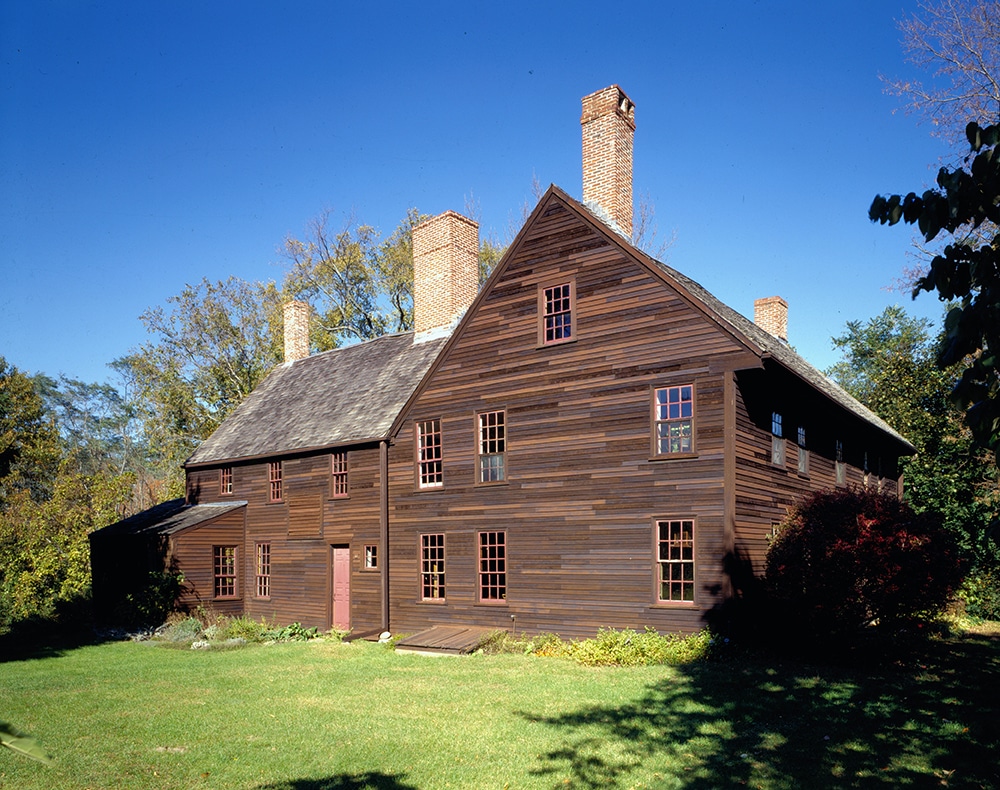Ask Historic New England | October 2017
I’ve seen houses with an outside door in the living room and been told it’s a “coffin door.” What does that mean? —James T., Portland, ME Features of old houses often acquire colorful names, and “coffin door” is one of these. Most frequently associated with 18th and early 19th-century houses in Connecticut, the coffin door […]

I’ve seen houses with an outside door in the living room and been told it’s a “coffin door.” What does that mean?—James T., Portland, ME
Features of old houses often acquire colorful names, and “coffin door” is one of these. Most frequently associated with 18th and early 19th-century houses in Connecticut, the coffin door is an exterior door located on the side of the house and typically situated near a corner of the side wall. Also known as an end, corner, or funeral door, this door opened not into an entrance or stair hall but directly into a main room, usually the parlor.
The term “coffin door” first appears in 20th-century house descriptions, so it’s unlikely it was known to the original builders. Historically, it probably became associated with funerals—when a family member died and loved ones gathered in the deceased’s home, not in a funeral home. The coffin would have been placed in the best room of the house, the parlor, and then brought to the church or cemetery for final services. The coffin door is thought to have allowed for a coffin to be moved directly out of the house from the parlor without making a tight turn into the main entrance. Whether that is the purpose for which coffin doors were built is not known, but the name has stuck nonetheless.
Sally Zimmerman Senior preservation services manager
During a recent trip to Vermont, I noticed a lot of funny-looking tilted windows squeezed up along the rooflines of old farmhouses. What’s the story behind them?—Darren K., Wilton, NH
Known for their frugality and ingenuity, 19th-century Yankees found often-quirky ways to reuse materials—hence the “witch window,” a double-hung sash window installed at an angle and fitted under the eave in the gable end of a house. Often these are found in two-story houses that have an added one-story or one-and-a-half-story ell on the side. Concentrated in central and northern Vermont but present all over New England, witch windows are also called “sideways” or “lazy” windows, in reference to their angle.
Though popular lore explains the angle as an attempt to prevent witches from flying straight in on a broomstick, the truth is more practical. Introducing a side addition at the gable end of the house typically meant one or two windows would get blocked. Rather than discard the windows or design custom ones to fit into the irregular gable space above the addition, the thinking went: Why not just tilt the window and fit it in under the eave to bring light and air into the second story? That sounds like a sensible Yankee decision!
Charlotte Barrett Community preservation manager, Western New England
What is pumpkin pine flooring?—Catey M., Bristol, RI
In today’s common real estate parlance, “pumpkin pine” flooring often refers to wide plank pine flooring that either has developed a warm orange glow over time or has obtained one from the way the wood has been treated, such as with high-resin tung oil.
This descriptive term dates back to at least the early 19th century and traditionally refers to the best-quality old-growth Eastern white pine. Unlike sapling pine from second-growth trees, pumpkin pine comes from the tallest old-growth trees (often called “mast pines,” as they were sought after for ship masts). Pumpkin pine has been valued since colonial times for its quality and durability. Its warmer appearance is possibly due to the resin content of old-growth heartwood relative to that of younger Eastern white pine. The warm glow is generally enhanced as the boards age.
Dylan Peacock Preservation services manager
Got a question about an old house you need answered? Submit your questions to Historic New England at: Editor@YankeePub.com. Historic New England is the oldest, largest, and most comprehensive regional heritage organization in the nation. Historic New England shares the region’s history through vast collections, publications, programs, museum properties, archives, and stories that document more than 400 years of life in New England. For more information visit: HistoricNewEngland.org.


